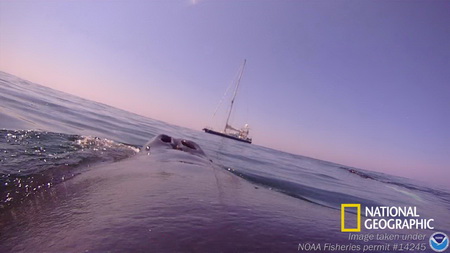After two weeks spent in the Gulf of Maine surrounded each day by bubble net feeding, breaching, lobtailing, pectoral flipper slapping humpbacks, the newest Song of the Whale team members have a whole new view on how whales see us. These recent weeks have been busy, working with the SBMNS team to track animals tagged with both D-Tags and or National Geographic Crittercams in order to further understand how whales use the water column, especially in regard to their prey. And there certainly has been a lot of whale prey around this week, sand eels have been seen leaping out of the humpback’s overflowing mouths and Crittercam footage has shown krill was also being eaten.
The days have been long, with several animals tagged a day, and a couple tagged overnight, where our patience was tried waiting for the familiar “click click” of the radio tag signal as the whale surfaces, desperately hoping that the whale will stay within our VHF range while the darkness surrounds us.
The field work was a success, many whales tagged and tracked, large areas of the Gulf of Maine prey mapped and the SOTW team have gathered many photogrametry images, testing our methods and providing additional data on the whales being studied. Analysis of all the data collected on this trip will continue within the many organisations involved for months but for 2012, the Stellwagen Bank National Marine Sanctuary, NOAA and IFAW D-Tag cruise is over.
So, leaving the most charismatic of whales, the humpback, off Cape Cod, Song of the Whale has now returned to Boston to make final preparations for departure to Iceland via Greenland and Canada, when the team will begin a search for one of the most endangered large whales on earth, the North Atlantic Right Whale.

Sorry, comments are closed for this post.